
Mar 4, 2022 | Tools
How many of the meetings that you attended in the last month had a focused and clear agenda, ran to time, and sought a useful contribution from each of the attendees? How many of those meetings had attendees who then agreed and noted down a set of actions? From the feedback we have collected from teams working on major projects, the answer probably is: ‘not many’. If one considers the huge amount of time and resource that goes into meetings, it is astonishing that project leaders and their commercial advisers do not put more effort into ensuring that meeting time is used effectively. Much has been written on this topic, but bad meetings continue to be a chronic problem in most project teams. So, what can be done to make a difference? I believe some effort should be applied to relearning the lost art of ‘chairing’… let’s take a further look.
The term “chairman” arose in the mid-17th century and was used to describe someone occupying the ‘chair of authority’ for a meeting, group, or corporate body; the person responsible for ensuring the effective outcome of the meeting. Over time, we seem to have interpreted that for the chair to hold authority, the role should always default to the most senior individual at the table, but this isn’t the case.
The prevailing assumption appears to be that chairing a meeting is simply a matter of being in charge, where seniority governs how contributions are made and should be received. We also face an interesting phenomenon that senior managers and leaders rarely think their own meetings are run badly, but can quickly identify the problems of poor leadership in meetings where they are only attendees. The suggestion that they might need to do some training in this area will often be swiftly dismissed, and so, organisations continue to propagate the habits and culture of bad meetings. Fortunately, there are some straightforward and easily applicable actions that leaders and attendees can follow to curb bad meeting culture, the question is, how?
The importance of effective meetings
People meeting in groups of four or more typically requires a degree of leadership to ensure the time spent is productive. To get the best out of any group event, people need a framework which that sets the expected boundaries of behaviour within which they can feel comfortable to express themselves and, be creative in their thinking, whilst engaging with the thoughts and ideas of others in the room.
For effective meetings, organisations need to adopt a framework and create a good meeting culture, this should be exampled by the project leaders and embraced by all team members.
A distinctive role
The Chair of a meeting should be seen by everyone as a distinct and essential role to having productive meetings. Defaulting to the most senior person is not necessarily the right option, especially, if they are needed as part of the discussion. The Chair needs to be able to take a step back from the content of the discussion and focus on using their skills to facilitate and keep the meeting on track – these distinct skills are not difficult to learn but are hugely important. Regardless of your seniority, you cannot assume that you have the right skills to chair a meeting – however, you can develop skills these skills and help your team have more effective meetings.

Chairing a better meeting
At a basic level, the primary skill for chairing a meeting is to learn to contract with the rest of the group. Contracting is a process used at the start to remind everyone of their shared purpose in attending the meeting. This is the most important part of the session as it provides everyone with the opportunity to become aligned with the required output of the meeting. The contracting process gains attendee consent to a short set of agreements at the start of the meeting which the Chair will use throughout to provide boundaries and to keep participants accountable. The agreements should align with the following:
- Reiterate purpose
The Chair should reiterate the purpose of the meeting and confirm agreement with the participants. Without an agreed purpose, it is easy for the discussion to be derailed by other urgent concerns. The Chair can use the agreed purpose to keep the meeting focused on what is important for that particular meeting.
- Agree on outputs
The Chair will agree on outputs with the attendees – they could be shared information, a technical solution or some initial thoughts and ideas, but there must be an agreement between those involved on the expected outputs from the meeting.
- Expected timings
The Chair should confirm timings with the group and offer an opportunity for anyone to communicate if they need to leave the meeting early.
- Common ground rules
People assembled as a group need a set of common ground rules within which to operate. When the ground rules are not explicitly stated, bad behaviours tend to creep in, and meetings become ineffective. The following ground rules should be stated by the Chair at the start of the meeting:
- Everyone present is expected to speak
- Everyone who speaks is allowed to be heard
- We have one conversation
- We stick to the topic
- Everyone stays present (no checking emails on your phone, etc.)
Everyone is then asked to state they agree. This might seem overly formal, but the point about these rules is that they create a verbal contract within the group which gives the Chair the authority to pull people back in line when they move off-topic, become disengaged or display other behaviours which may take the meeting off track.
- Taking notes
One of the most important roles in any meeting is to agree on who is going to take a formal set of notes. This is a particular problem in meetings among senior people, as note-taking is traditionally regarded as a task for junior staff and often ignored. The problem is, without some form of record of the discussion, it is very easy for each participant to walk out of the room with a different interpretation of what was agreed. As a bare minimum, the Chair should ensure a written note is circulated that summarises:
- The date;
- Who attended;
- The matter under discussion;
- Agreed actions by whom and by when.
Again, this may seem basic, but in a major project, hundreds of meetings take place every day, and if it is common practice to meet without formal notes, decisions often become blurred or misinterpreted.
Advanced chairing skills
Once the meeting is off to the right start, with everyone focused on the agenda, and following the ground rules there are, however, additional skills that can be very useful when dealing with ‘difficult’ meetings. These include:
- Identifying the introverted thinkers and ensuring they contribute
- Managing extroverted thinkers who continually interrupt others
- Reading the dynamics of the room to identify interrelationships and how they influence the discussion
- ‘Hearing’ what is not being said to identify issues people may be avoiding
- Managing outsized egos who want to push their own agenda
- Avoiding ambiguous decisions that allow different interpretations of what is being agreed
These are skills that aren’t essential at the beginning but are skills that every Chair should aspire to learn over time.
Final thoughts
What can we take away from this? Project leaders need to ensure that all meetings are effective – to do this, they need to make sure team members are aware of the specific framework needed for meetings and ensure that there is someone competent to take the role of Chair. The Chair must be trained in the various skills mentioned above in order for them to facilitate the meeting well. These behavioural changes will help teams focus on the topic at hand and use their meeting time effectively.
As a final thought, consider how many meetings you will be involved in across your project this week – perhaps you are taking the role of chair for several of them. How might you adopt a structured approach to chairing these meetings and what would the effect be on the productivity of your time and others in your team?

Jan 28, 2022 | News and insight
Event date: Wednesday 19th January 2022
The Major Projects Association hosted a thoughtful panel discussion on the skills needed to deliver major projects in the future. It is apparent that many factors are driving the need to consider this issue at present: the speed of technological development and environmental change, the increasingly complex and layered nature of major projects, changes in our social organisation and the way we approach and think about work, to name a few. Though the panel didn’t provide all the answers, a consensus did emerge around the need to have a more robust approach to developing behavioural skills in project leaders.
The panel discussed how our modern world more than ever before, the role of a person in an organisation is to engage with others to deliver impact, elevating the need for hyperconnectivity, empathy, agility, and effective people management. The “land of skills scarcity” in project delivery is expected to persist, and with multiple vacant roles available for every qualified project manager, the most successful projects will be those that are able to manage and apply resources and talent better than others. The panel also considered the deficit in technical skills, especially relating to net zero targets. Achieving our sustainability goals will require huge social changes, both domestically and in the infrastructure we deliver. Major projects of the future should be about delivering in response to what we need, going back to the beginning with a mindset to question the need for the project in the first place.
Some of our key takeaways:
- We have to use a different set of eyes to think about what skills we will need to deliver major projects in the future. The context will re-define a lot of things, as we have all experienced over the last couple of years with the pandemic.
- We can use the need to change as an opportunity to diversify our teams and access greater talent. To do that we need to develop a diversity in ways of working that enables a wider range of people to deliver effectively and consistently.
- The ‘superhero leader’ mindset will not serve us well as we deal with increasing complexity. We must instead leverage the strengths of everyone through collaboration, making room for people to be themselves and do what they do best.
- The challenge around skills is often more about how effectively organisational leaders are able to manage change in society – responding to the complexity and unpredictability of our reality.
Chair: Nathan Baker Chief Executive Institute of Occupational Medicine
Panel:
- Josie Cluer Partner EY
- Michelle Lambon-Wilks Development Director National College for Nuclear
- Rob Leslie-Carter Director Arup
- Sarah Mukherjee MBE Chief Executive IEMA

Jan 13, 2022 | News and insight
What is it?
Changing Behaviours in Construction is a practical document, written as a collaborative effort between ResoLex and some of our associates. We came together to reflect on the government’s Construction Playbook and developed some practical advice for project leaders to be able to successfully implement the directives in the Playbook, through building and maintaining strong, high-performing teams.
Who is it written for?
The document is primarily aimed at project leaders and those responsible and accountable for successful project delivery. The eight themes in the document should however resonate with professionals throughout the team and we hope to provide tools that can be easily implemented by people in a number of different roles.
What are the key takeaways?
There are actions that can be taken, both early in the setup of the project and later as the team develops, that will enable projects to achieve the shifts in performance required by the Construction Playbook. We have divided our thoughts and suggested actions into eight key themes and also provided a quick rundown of our top 10 suggestions for improving performance through collaborative behaviours.
Read or download ‘Changing Behaviours in Construction’ here!
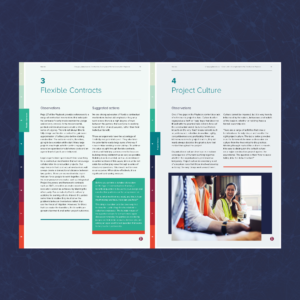


Dec 14, 2021 | News and insight
We are delighted to welcome Elle to the ResoLex Team! Elle is our new Marketing and Communications Manager and the fact you’re reading this means she is already succeeding!

Elle is a self-starter with experience in all things marketing and communications, from social media management, content creation, brand management to event planning and is a great match to our values and team working ethos.
Within ResoLex the role is broader than in many organisations and Elle wears many hats (we all wear pretty fancy ones) – living by our collaborative values. Part of her role is to communicate our knowledge and experience, share some practical resources to help your teams and of course, market how great we are!
In the new year, you’ll see a host of the ever so popular and engaging Roundtable events and see our Professional Learning Network grow – get in touch with her On LinkedIn or via email ([email protected]) if you’d like some more information or to just say hi!
Meet the rest of the ResoLex team and our associates here.

Nov 29, 2021 | Events
It was great to be back in the room with leading construction industry professionals for Digital Construction Week 2021. Not only did we meet some great people, but we were also delighted to share our ‘Top Five Suggestions for Improving Project Performance through Collaborative Behaviours’ on the ‘People and Change Stage’.
The construction industry has come under criticism for low productivity over many years. Together with previous initiatives, the Construction Playbook speaks to some of the key challenges we need to overcome to get better, faster and greener delivery of projects. Current studies show that:
“…only 35% [of projects are] on or under budget and 32% on or ahead of schedule…” Deltex Clarity Industry Report/Riba Journey, Aug 21
‘The Construction Playbook’ requires all public bodies who commission construction projects to ‘comply’ or ’explain’ and has the intention to generate a step-change in project performance. The Playbook provides some clear approaches to what we need to do, though it doesn’t explain how to achieve behavioural change.
In our complimentary report, ‘Changing Behaviours in Construction: A complement to the Construction Playbook’, we have considered the cultural and behavioural changes needed to enable this transformation of the industry and explained some best practice tools that project leaders can use to improve performance.
There is a flawed assumption that project professionals should be able to behave logically and rationally and, that cooperation and collaboration should automatically happen irrespective of circumstances – known as The Collaboration Fallacy. After 20 years of experience working with major project teams, at ResoLex, we know how important it is to invest time in teams to develop the right behaviours and procedures to work collaboratively and in turn effectively.
Top Five Suggestions for Improving Project Performance through Collaborative Behaviours
1. Front-end loading
Front end loading is a project management concept where time is prioritised at the start to think through the project’s implications and its needs. If we resist the collective industry urge to press on and start quickly, there is the opportunity to influence behaviours at the beginning when team behavioural norms are still forming. This involves pulling key individuals into a series of discussions where the multiple problems that can generate complexity can be worked through. It requires an underlying mindset that doesn’t push every difficult issue down the road to be sorted out later.
Getting on board with the concept of front-end loading and allowing more time to think clearly and articulate how to achieve the desired outcomes, will result in a big payoff further downstream.
Our recommendation:
A great way to stimulate a high-level strategic conversation around a project’s needs is to use a version of our strategy canvas. The one we have developed has 8 key areas, each of which prompts a series of questions for discussion about the internal and external factors.
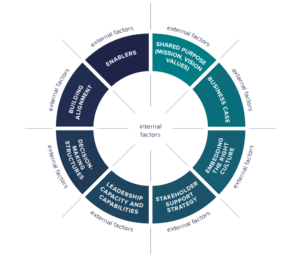
2. Selecting the right team leaders
When selecting both the leadership structure and the individuals who will take on senior roles in the team, focus not only on their technical experience but also on their ability to deal with the social complexity of delivering major projects.
There are three primary elements to every construction project:
- Technical – the knowledge and awareness of how the project components are designed and assembled.
- Commercial – the knowledge and awareness of issues around money, contracts and the identification and management of risk.
- Social – the knowledge and awareness of how we behave in groups and teams.
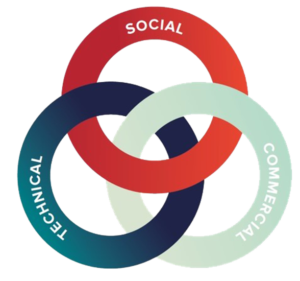
The key is that the three are intrinsically linked. High performance cannot be achieved if we are not doing enough to enhance and maintain the social competence of our teams – particularly those in leadership roles – alongside their technical and commercial development.
Our recommendation:
The step-change in performance comes when project leaders also develop and use the skills and capabilities associated with social intelligence, for instance:
- Understanding group dynamics
- Motivational drivers
- Systems thinking
- Balancing trust vs control
- Conflict resolution
- Team resilience
3. Measuring cultural development
The Construction Playbook suggests using a project scorecard and setting out various measurements in the form of KPI’s. The challenge is, how do we measure behaviours?
At ResoLex, we look at this in a couple of different ways. We measure behavioural risk and track early warning signals around 4 key areas using our proprietary tool, RADAR. This helps teams understand the short-term actions they can take to improve behaviours. We also measure cultural maturity using a matrix approach and help teams create long-term development plans to embed the desired culture.
Our recommendation:
Tool no.42 from our Collaboration Director, Tony Llewellyn’s Team Coaching Toolkit helps teams identify the behavioural indicators with a simple measurement methodology providing low and high scores.
4. Aligning to a common goal
Chapter four of the Playbook recognises the importance of creating alignment and clarity between the project team, primary decision maker and key stakeholders.
Our many years of research into team performance have helped us understand that group behaviour can be influenced if the team members bond through a range of exercises that are designed to tap into the emotional connections needed to grow trust.
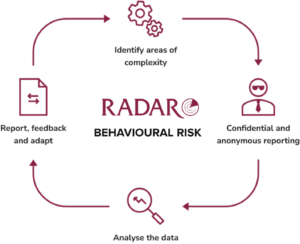
Our recommendation:
We recommend taking the time to get every team aligned to a common goal and a common project culture through a team setup process, including compulsory early workshops covering the seven core team development areas mentioned below:
- Articulate a clear vision
- Actionable values
- Build relationships
- Roles and accountabilities
- Rules of engagement
- Test assumptions
- Conflict management
5. Adjusting the mindset of conflict avoidance
Whilst conflict is fundamental to organisations, unfortunately, it is also something that we naturally want to avoid! But conflict is part of prioritising, planning, strategy, resource allocation, design and everything else in an organisation – or at least it should be. The ability of leaders to work through opposing sides of challenging emotional and political discussions and arrive at a resolution is in the best interests of the team, the client, the stakeholders and the shareholders.
In overcoming conflict, we need to adjust our mindset and think about the positive outcomes. First, acknowledge that conflict is productive and that your team may have a natural tendency to avoid it. We can base our new conflict mindset on the idea that there is more than one right, more than one version of the truth, more than one perspective. Underpin it with the belief that diversity of thought leads to better outcomes.
Our recommendation:
A ‘No Blame Culture’ is regularly set as the goal for teams coming together. Using something like this ‘No Blame Protocol’ can help give clear expectations to the team on how to approach a difficult situation.
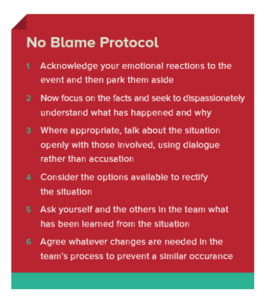
Through our five suggested best practices, we have highlighted some tools that you as leaders can use to improve your collaborative team performance.
We hope that these recommendations and tools will help you and your teams work better together to deliver projects more efficiently. If you would like further guidance, please contact us or sign up to join our Professional Learning Network, full of peer-to-peer roundtable events, resources and advice: https://resolex.com/resources/












